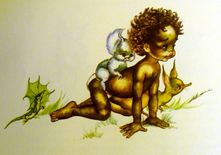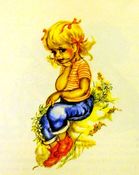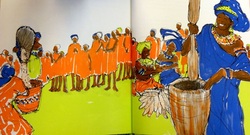Tinka and Nomi: The Wild Loner versus The Community
Tinka and His Friends by Brownie Downing and John Mansfield (1960) which uses the term piccaninny on the first page, tells the story of a child who has lots of animal friends (because he knew the "language of the birds and wild animals") and meets a girl, Shelley, just as he and his friends are hiding from a crocodile (but it's actually Shelley) they are afraid is going to eat them. They all go on a journey related to Shelley's long and flowing golden hair because she wanted two medium-sized pigtails. Above are two images from the book, one of Tinka, and the other of Shelley. The portrayal of Tinka as a barefoot, unclothed, wild person is characterized here as he looks similar to his animal friends and is positioned like an animal, wild and unkempt, with a rather muscularly defined build. On the other hand, Shelley is innocent, demure, pure, and pristine looking; she is also clothed and wearing shoes. This image of Tinka is indicative of both the piccaninny and "Mandingo" stereotypes cultivated in society. The Mandingo stereotype perpetuates the myth of African males as being animalistic, bestial, and primitive. It is also critical that the image is of a female whose skin color is different from Tinka's which is also important to the Mandingo stereotype which places emphasis on a relationship, or desire for this "other" (lighter-skinned person) by the (darker) male.
In contrast to Tinka, this is an image from Nomi and the Magic Fish: A Story from Africa (1972) by Phumla and illustrated by Carole Byard. This shows a community of people as opposed to a lone person out in the wild living like an animal. There are no exaggerated features on anyone and the characters in this image are clothed "traditionally", yet still barefoot, which again leaves room for argument that this image isn't quite culturally conscious either. The image used from Fly Eagle Fly dated 2000, is quite different from this one dated 1972.



